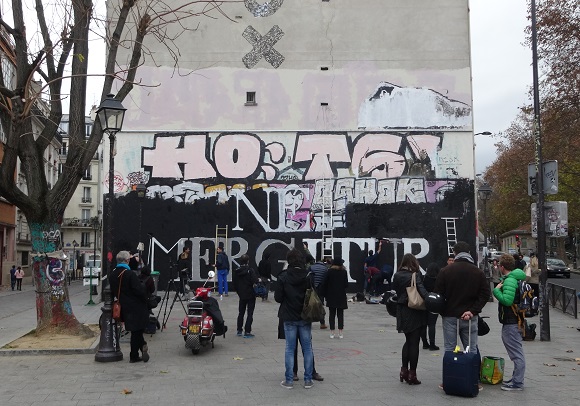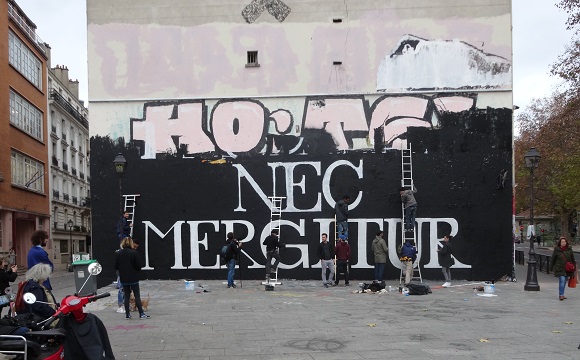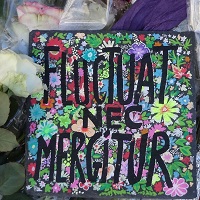
Fluctuat nec mergitur, the motto that appears on the heraldry or coat of arms of the City of Paris, came to the forefront as Parisians and others began to rally around slogans in the aftermath of the terrorist attacks of November 13, 2015. This is the occasion to recall the history of the city’s heraldry and the significance of the elements that make up the city’s coat of arms.
Immediately after the attack of January 7, 2015 Paris was “Charlie” in solidarity with the individuals and values under fire at Charlie Hebdo, though some refused the refrain. After the further attack of January 9 at Hyper Casher and the manhunt for the perpetrators of the terror, some would also add a oneness with Jews and police to their slogan, but “Je suis Charlie” became the three overarching words.
“Fluctuat nec mergitur,” the motto of Paris for centuries, meaning that (it is) tossed about (by the waves but) not sunk/submerged, immediately began appearing as a slogan in the wake of the killing spree of Nov. 13.
The words first appeared at the attack sites-cum-memorials on the morning of November 14. Here is one of its initial expressions as it was written on a flag placed on the ground in front of the bar Le Carillon, one of the first sites be hit in Paris during the wave of attacks. Along with fluctuat nec mergitur, the individual had also written Paris: ville lumière (city of light).
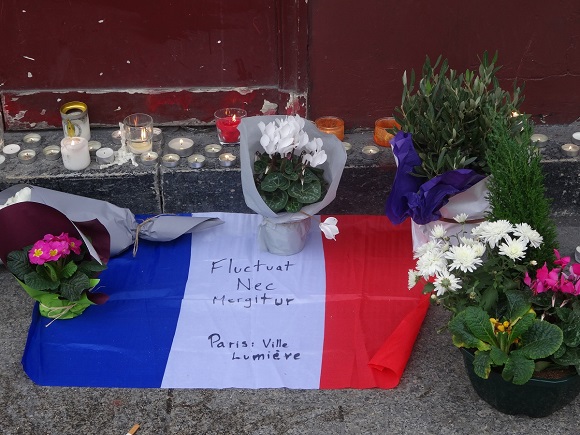
Two and half days later, hundreds of candles, flowers and other slogans have be placed on the sidewalk along with the flag, which can barely be seen peeking out from beside the wall.
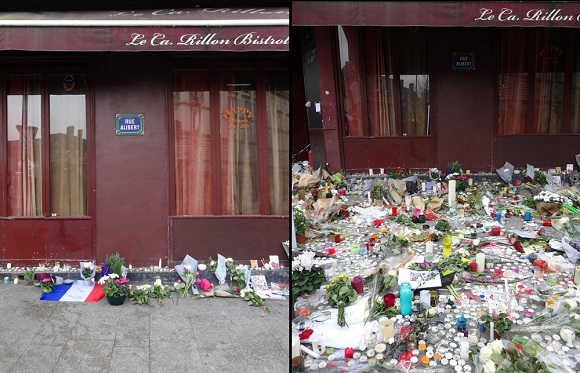
By then the motto/slogan was appearing here and there throughout the city, though certainly not as extensively, affirmatively and meaningfully as “Je suis Charlie.” Three Latin words can only go so far in a slogan- and logo-hungry world. Nevertheless, they began to crop up, white letters against a black background, and nowhere more visible than on Place de la République.
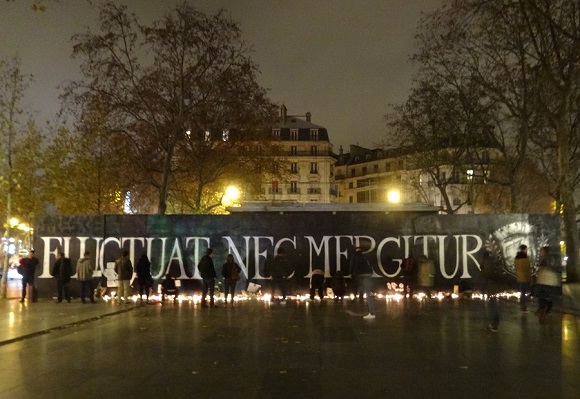
A team went to work to paint those words on the side of a building by Canal Saint Martin in the 10th arrondissement.

The coat of arms or heraldry of the City of Paris has evolved over time, but more than the motto itself, one element that has remained constant is the use of a ship to represent the administration of Paris.
As the Gallo-Roman city of Lutetia, home to the Celtic tribe of the Parisii, developed along the Seine River 2000 years ago, the boatmen naturally gained in stature. These boatmen or nautes were organized under the title Nautae Parisiaci (not to be confused with naughty Parisians). The Nautae Parisiaci donated a stone pillar or monument to the temple of Jupiter, on the site where a Christian basilica would later be built and eventually by Notre-Dame Cathedral. In the Cluny Museum of the Middle Ages, built partly on the site of Roman baths on the Left Bank, visitors can see that pillar, which was excavated from beneath Notre-Dame. The pillar of the nautes honors Roman and Celtic gods.
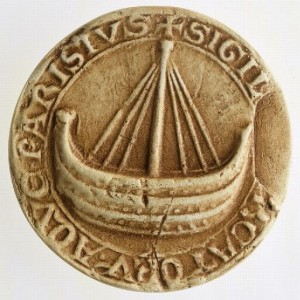
In the Middle Ages, the powerful corporation that operated commerce along the Seine in Paris was called that of “the water merchants.” Paris was a royal city by then, though the king was frequently elsewhere. Under Louis VII in the 1170s, the important role of these water merchants was affirmed with privileges, further reinforced under the long reign of his son Philippe Auguste. The title “provost of the merchants” was given to the head of the corporation, placing him in the position of leader of the municipal administration of Paris. The National Archives in Paris have a mold of the seal of the water merchants of 1210.
The main offices of the water merchants were naturally near the docks. One of the main docks was on the Right Bank, just across from Ile de la Cité, the island at the center of the city. Place de Grève was the name of that docking area. The grève refers to the sandbanks that were once there. Men would assemble by these docks when looking for work (and when dissatisfied at not having work). Standing or being on the grève came to mean one was looking for work, but that meaning changed over time and in the 19th century being on the grève came to refer, as it still does, to the voluntary stopping of work as a sign of protest or complaint, i.e. to strike.
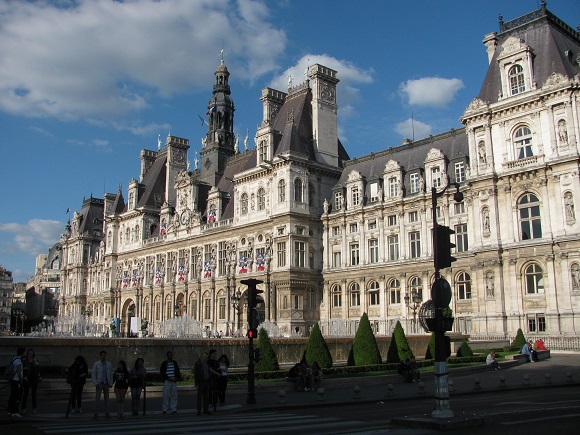
In 1357 the water merchants purchased a building for municipal use. City Hall stands on that site today, which is only natural since the water merchants assumed the many of the roles of what we think of as the mayor’s office would. The chief city administrator continued to be referred to as “the provost of the merchants” until July 14, 1789, the day of the storming of the Bastille, when the provost was assassinated by gunshot by someone in the angry mob that saw him as a traitor to the cause of their grief against the king. His head was then paraded through the streets on a spike. Since then the leading administrator of city has been called “the mayor.”
The square beside City Hall (Hôtel de Ville) was renamed Place de l’Hôtel de Ville in 1803. Since 2013, on the 69th anniversary of the Liberation of Paris from German occupation, it has officially been called Place de l’Hôtel de Ville – Esplanade de la Libération.
The current City Hall was completed in 1882, partially echoing the style of the 16th-century building that was set aflame in 1871 in the final days of the Commune of Paris.
Tour boats are now the most common vessels seen plying the Seine River as it passes through Paris, yet the sailing merchant ship remains the central element of the symbol of the City of Paris. In particular, it is a silver ship with a silver sail that navigates against a red (gules) background.

Above the ship are golden fleurs de lys (stylized lilies, symbols of French royalty) against an azure blue background, a reminder that this was once a royal city. Paris was also surrounded by ramparts, hence the crenelated crown at the top.
Oak leaves decorate the left side (as the viewer sees it). Laurel leaves decorate the right. Both symbolize heroism.
“Hanging” from the crossed branches at the bottom, the Legion of Honor was added to the motto by decree of October 9, 1900.
To its right was added the Croix de Guerre (à l’ordre de l’Armée) on July 28, 1919. As is written in the decree signed by President Georges Clemenceau (and inscribed on the stone barrier in front of City Hall): “The City of Paris, capital magnificently worthy of France, propelled by a patriotic faith that never waned, withstood with valor equally firm and smiling numerous bombardments by planes and by long-range artillery… from 1914 to 1918 add[ing] imperishable titles to its secular glory.”
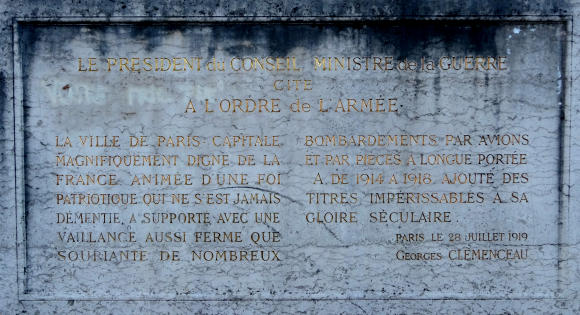
Even before the Second World War had ended, the Croix de la Liberation was added to the left of the Legion of Honor on March 24, 1945. As is written in the decree signed by Charles de Gaulle on behalf of the provisional government (and also inscribed on the stone barrier in front of City Hall): “Capital faithful to itself and to France manifested… its unshakable resolution to combat and to vanquish. By its courage in the presence of invaders and by the unconquerable energy with which she [it] withstood the most cruel triels, deerves to remain the example for the entire nation… The city… liberated by its own efforts then united with the advance guard of the French army come to its rescue on 25 August…”
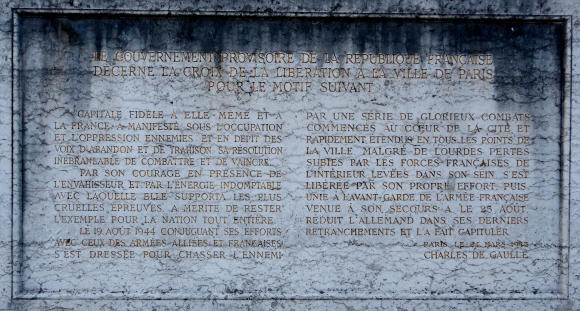
The astute visitor will spot the coat of arms of Paris in whole or in part throughout the capital city.
For example, you’ll notice a ship decorating the streetlamps on Place de la Concorde.
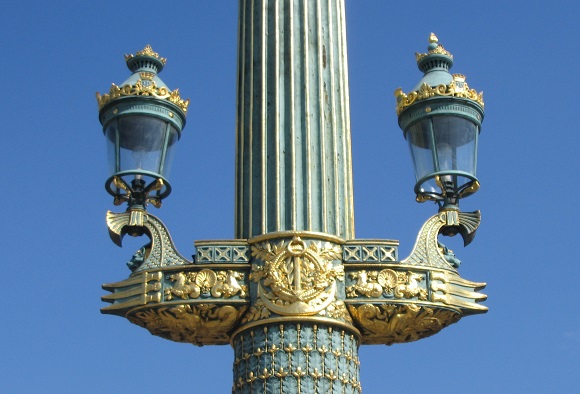
You’ll see a mosaic representation of the city’s coat of arms by the center of the metro track on line 1 at the Hôtel de Ville station:

You’ll see symbols of the city on the elevated structures of the metro along Boulevard de la Chapelle and at La Motte Picquet-Grenelle:
Keep your eyes open and you’ll see elements of the coat of arms of the capital at countless other places around the city: train stations, bridges, schools, municipal buildings, etc.
As I write this, however, in the wake of the terrorist attacks of November 13, it’s the motto Fluctuat nec mergitur that stands out as a sign of Paris as it tries to stay the course of liberté, egalité, a seat with friends on the terrace of a café.
© 2015, Gary Lee Kraut


